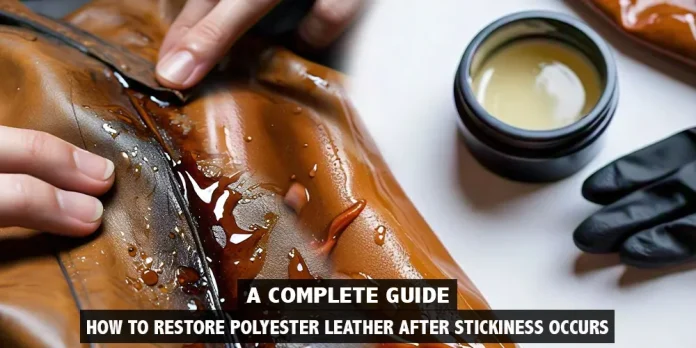How to Restore Polyester Leather After Stickiness Occurs
Polyester leather, synthetic or faux leather, is highly prized for its affordability, durability, and cruelty-free nature. However, stickiness can often be experienced due to environmental conditions, poor cleaning, or general wear and tear over time – often leaving its users uncomfortable to touch while potentially even damaging its surface material. If left untreated it could even damage this faux leather surface further and potentially endanger its future.
In this guide, we’ll cover why polyester leather becomes sticky and how best to restore it to its original, smooth state.
Why Does Polyester Leather Become Sticky?
Before diving into cleaning and restoration methods for polyester leather upholstery, it is necessary to understand why it may become sticky over time. There can be various reasons:
- Aging of the Material: Over time, plasticizers used in synthetic leather to soften and bend it may degrade over time, leaving behind an unpleasant residue that adheres to surfaces like shoes.
- Heat and Humidity Exposure: Overheat or humidity can make polyester leather sticky when it absorbs moisture from the air, especially if its material absorbs it as part of its properties.
- Improper Cleaning: Substituting cleaning products that contain harsh chemicals or alcohol-based cleaners with cleaning solutions that leave behind sticky residue can leave faux leather surfaces with an unsightly stain and can even leave behind sticky fingerprints on their surfaces.
- Dirt and Oils: Everyday use can lead to the accumulation of dirt, oils, and sweat on polyester leather surfaces making their surfaces sticky and making everyday living uncomfortable.
- Poor Storage: Storing polyester leather items in hot, humid conditions without proper ventilation may cause its material to degrade and become sticky, leading to sticky fingers or disintegration altogether.
Now that we understand possible causes, let’s consider some effective remedies to restore sticky polyester leather.
Step-by-Step Guide to Restoring Sticky Polyester Leather
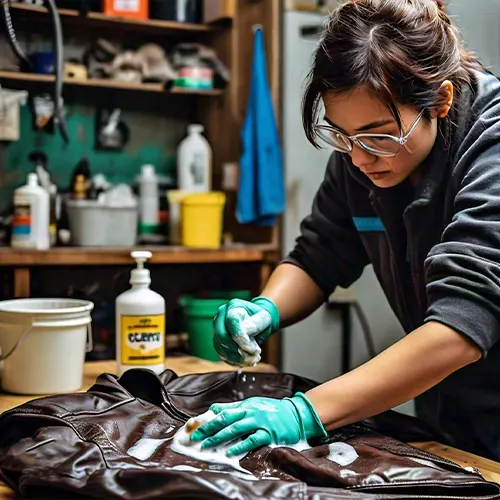
1. Clean the Surface with a Mild Soap Solution
Step one in restoring sticky polyester leather should involve giving it a thorough cleaning with a mild soap solution to remove surface dirt, oils, and sticky residues that could be the source of its stickiness. This step also serves to flush away harmful substances like silicones that might contribute to its problem.
Materials Needed:
- Mild liquid soap or dish soap
- Warm water
- A soft cloth or microfiber towel
- A dry towel
Instructions:
- Combine some mild soap with warm water for an effective but gentle cleaning solution.
- Soak a soft cloth or microfiber towel in soapy water.
- Gently wipe any sticky areas on the polyester leather material while being careful not to oversaturate it with moisture.
- After wiping, use a clean damp cloth to wipe off any remaining soap residue from surfaces.
- Once dry, use a towel to pat down and allow air drying for at least 24 hours to ensure complete drying time.
Effect: This method for cleaning faux leather helps eliminate dirt and surface stickiness without harming its fibers or surface texture. Mild soap provides gentle enough cleansing without leaving behind unwanted residue deposits.
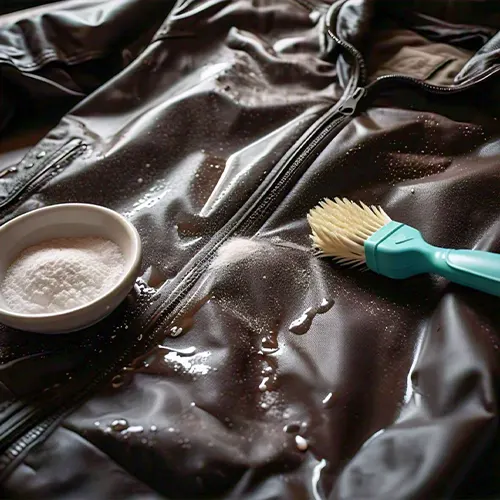
2. Use Baking Soda for Deep Cleaning
If soap and water have failed to clear away stickiness from polyester leather surfaces, baking soda could provide an effective natural remedy to absorb oils and sticky residues from its surface.
Materials Needed:
- Baking soda
- Water (optional for a paste)
- Soft brush or cloth
Instructions:
- Spread a light layer of baking soda directly over any sticky spots on polyester leather.
- Allowing baking soda to rest for 15-30 minutes allows it to absorb oils and residue.
- Gently brush away any baking soda with a soft cloth or brush.
- If the stickiness persists, create a paste by mixing baking soda with a small amount of water, scrubbing gently on the affected area until done.
- Wipe away any remaining residue with a damp, clean cloth and leave the material to air-dry before proceeding further.
Effect: Baking soda can help remove sticky substances, leaving surfaces looking and feeling fresh and clean.
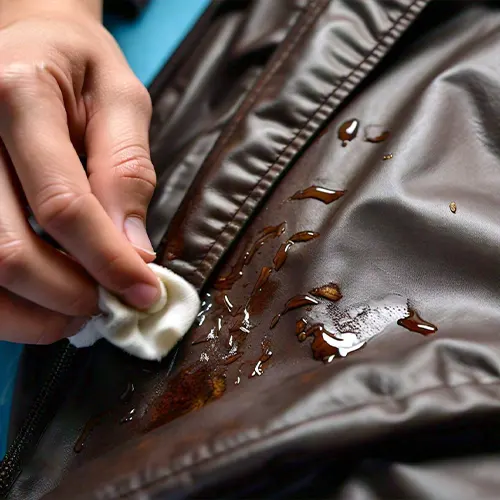
3. Use Vinegar and Water for Tough Stickiness
Stickiness may require stronger measures, in such instances, diluting vinegar with water may help break down sticky deposits without harming faux leather materials.
Materials Needed:
- White vinegar
- Water
- A spray bottle (optional)
- Soft cloth or sponge
Instructions:
- Combine equal portions of white vinegar and water in a spray bottle or bowl, for use as cleaning fluid.
- Carefully spray or apply the mixture onto any sticky spots on polyester leather.
- Gently wipe the surface using a soft cloth or sponge in circular movements.
- Once the sticky substance has been eliminated, wipe down the area with a damp, clean cloth to wipe away any vinegar residue that remains on it.
- Make sure to dry the surface carefully with a towel.
Effect: Vinegar can effectively degrade sticky substances while simultaneously disinfecting materials, making it an excellent way to deal with stubborn residue.
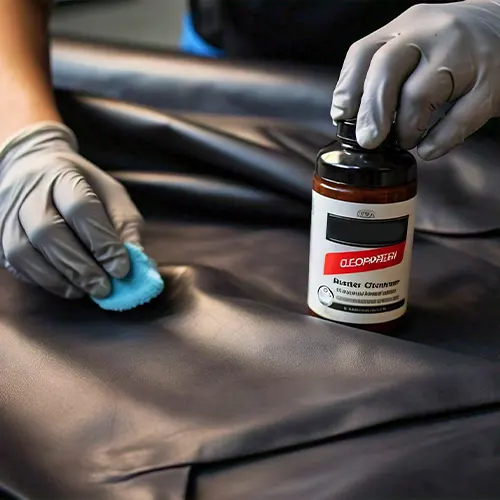
4. Apply a Faux Leather Cleaner or Conditioner
After cleaning polyester leather to remove sticky residues, adding faux leather cleaner or conditioner may help restore its original texture while also helping prevent further stickiness.
Materials Needed:
- Faux leather cleaner or conditioner
- Soft cloth
Instructions:
- Apply a small amount of faux leather cleaner or conditioner onto a soft cloth and rub in.
- Gently rub it onto the surface of polyester leather, paying special attention to once-sticky areas.
- Allow the conditioner to soak into the fabric for at least the time recommended in its product instructions.
- Use a damp cloth to gently wipe away any surplus product.
Effect: Faux leather conditioner not only restores softness and flexibility to its material but also offers protection from future stickiness.
Preventing Stickiness in the Future
Once your polyester leather has been restored to its former condition, it’s important to take steps to prevent stickiness from reoccurring. Here are a few suggestions on keeping polyester leather looking its best:
- Avoid Excessive Heat and Humidity: Store polyester leather goods in a cool and dry area to avoid heat or humidity from making the material sticky and damaging it over time.
- Use the Right Cleaning Products: Use only mild soap solutions, vinegar, or specialty faux leather cleaners to avoid leaving sticky residues behind.
- Condition Regularly: Applying faux leather conditioner on an ongoing basis is one way of maintaining its flexibility and softness – as well as decreasing its likelihood of sticking together or becoming sticky – keeping the material flexible, soft, and manageable for years.
- Proper Storage: Polyester leather jackets and accessories should be stored on hangers or in an environment with sufficient ventilation, to avoid moisture build-up or oil build-up.
- Keep Away from Harsh Chemicals: Avoid alcohol-based and abrasive cleaners as these could damage polyester leather surfaces and lead to stickiness.
Conclusion
Sticky polyester leather can be an infuriating hassle, but with proper techniques, you can quickly restore its original smoothness. By employing simple cleaning methods such as mild soap solutions, baking soda, vinegar, and faux leather conditioners you can effectively eliminate stickiness while lengthening its lifespan and preserving its integrity for extended use.
Preventative measures such as proper storage, regular conditioning, and the avoidance of harsh chemicals will go far in keeping polyester leather soft, flexible, and free of stickiness in the long term. By following such care regiments your faux leather jackets, bags or furniture will remain stylish yet comfortable for many years to come.


